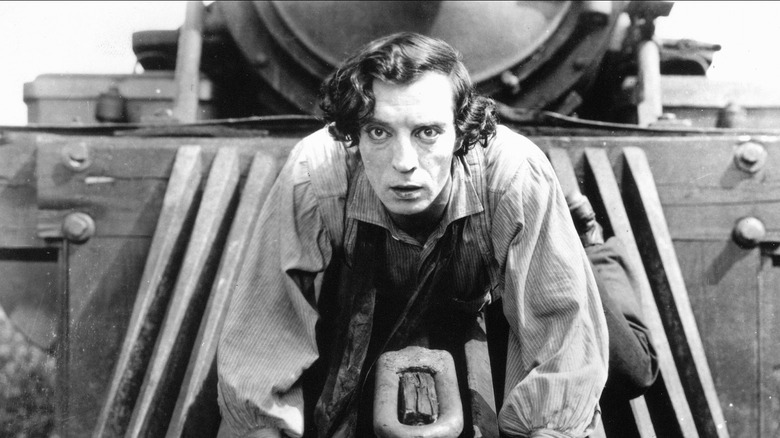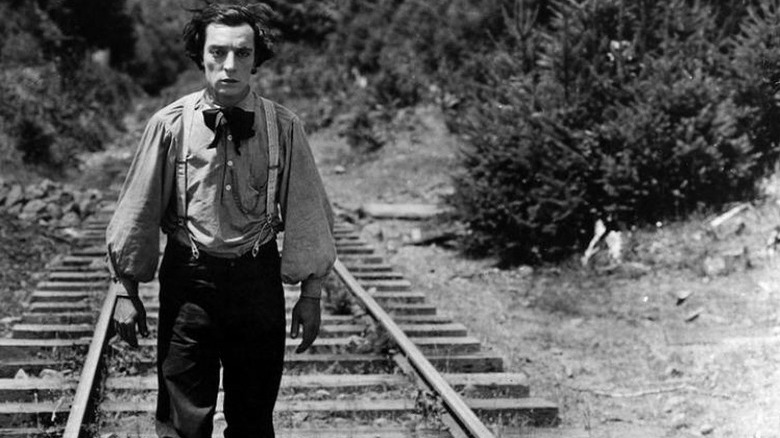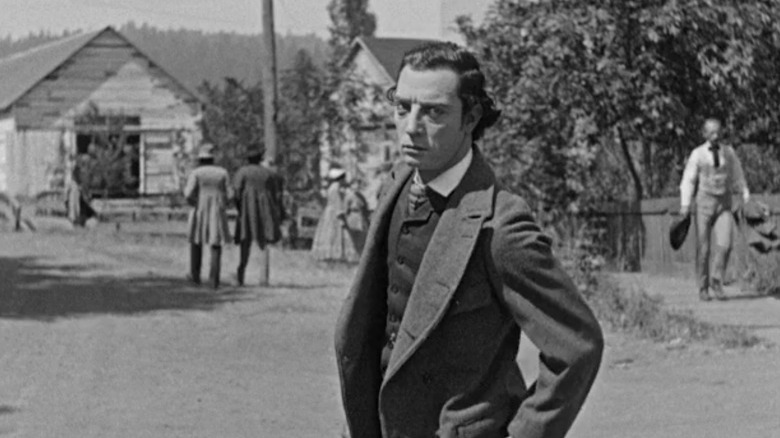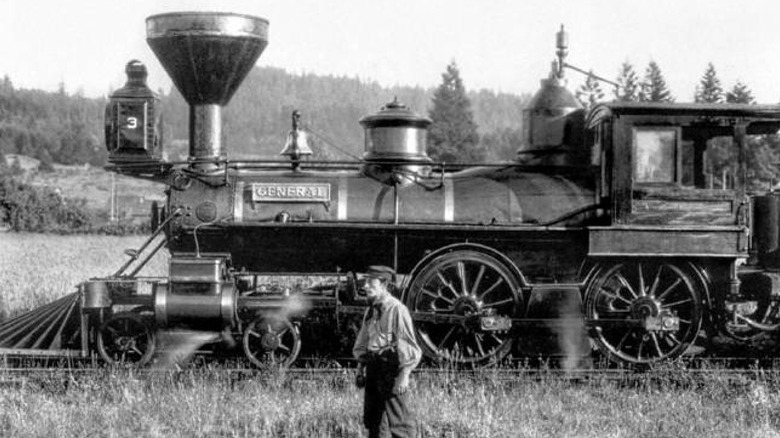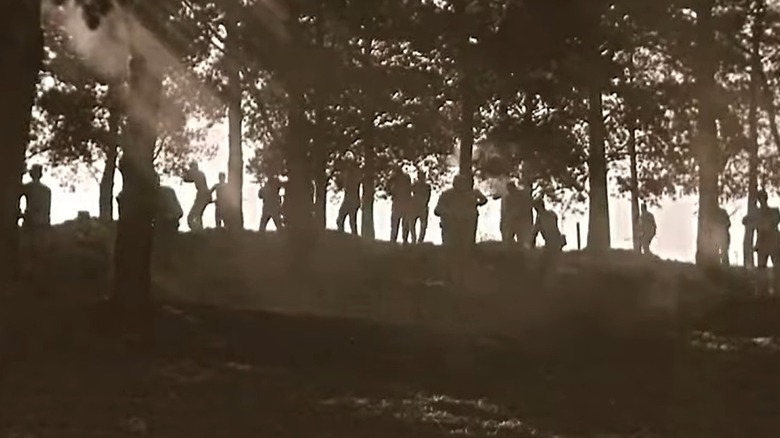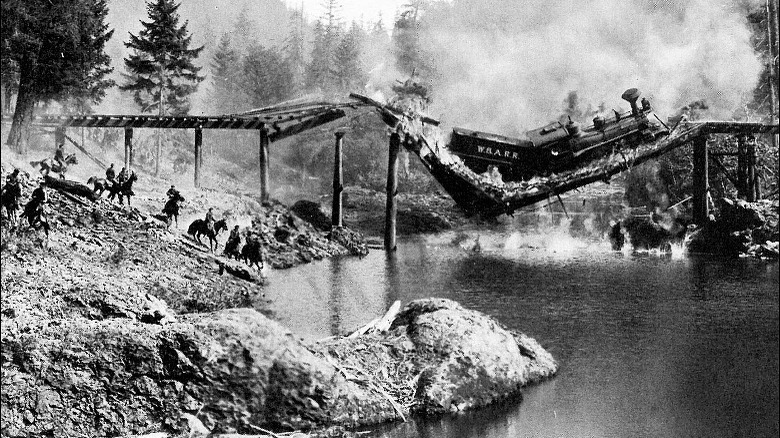The Story Behind The Most Expensive Shot In Silent Film History
Any Buster Keaton movie is a feast of visual invention and breakneck energy — to the point of wondering if some of the performers ever broke their necks — which is part of why they continue to hold up, even in the 21st century. To see the man in his prime is to see a true death-defier, one who braved the wilderness that was the world of early cinema and conquered it with grace and fearlessness.
In his 1926 film "The General," Keaton gave audiences what they wanted in the form of a chaotic romp and unpredictable stunts. He also delivered spectacle, with an episode of Civil War history that he could shape into a classic Buster Keaton experience. Keaton's movie was like the 19th-century equivalent of the post-apocalyptic car chase of "Mad Max: Fury Road," as director George Miller readily admits. Rather than futuristic, modded vehicles, it's a movie of trains, one that was also dangerous.
And very expensive. As with any Keaton movie, you watch it in awe of the gags and stunts. But "The General," both in its subject matter and scale, operates on a different level. Here, Keaton's characteristic grace and physicality are wedded to (and clashing against) the unstoppable, unceasing travel of the locomotive. In using those trains, Keaton gave himself a difficult and complex workload.
But beyond that, he burdened the movie with a high budget and a particular shot that ranks among the most expensive of any shot in the silent era. In fact, some sources call it the most expensive. It's definitely the most iconic, a shot that even now has viewers wondering how they did it: an extreme wide shot of a train, moving through the woods, falling through a collapsing bridge into the river below as soldiers ford it.
The great locomotive chase
It's 1861 in Georgia, and word is spreading around town that war is coming. Every man in town signs up to enlist, but the hapless train engineer Johnnie Gray (Buster Keaton) is deemed ineligible, a better fit for the Confederate army as an engineer. Instead of joining the cause, he gets back to working on his train, the titular "General," one of the two loves of his life. The other love is Annabelle Lee (Marion Mack), who rejects him when he can't make it into the army.
According to James Curtis' "Buster Keaton: A Filmmaker's Life," Keaton was given the story by his regular co-writer and collaborator, a storied comedic writer and filmmaker named Clyde Bruckman. He had found a book by Union Civil War veteran William Pittenger called "The Great Locomotive Chase," a nonfiction account of a wild moment in the war's history, in which a small Union dispatch stole a train from the Deep South. As the Confederates chased the rogue train up north, the Union soldiers left fires and downed trees in their wake, making for an enormously difficult pursuit.
The operation was complex, and doing justice to the book would lead to, as Keaton recalled Bruckman saying, "A lot of film with no laughs in it." So they reshaped it. For one, the story wouldn't be told from the perspective of Union spies, but from the Confederates whose trains are stolen. Being on the losing side of the war was a more natural fit for Keaton's famous sad loner shtick.
As repellent as it is for modern audiences, the establishing context of the Civil War is limited mostly to the first reel. The true story was gutted for a movie full of some of Keaton's most daring work ever, as his character fights for his train.
Up in Cottage Grove
Finding a proper location for the production of "The General" proved to be a difficult task. Buster Keaton's not insubstantial perfectionism meant that the look had to be just right, which first led the production team to scout the real South. Per James Curtis, Keaton went from "Atlanta, Georgia to Chattanooga" and still was unable to find a suitable location to stage his feature-length train chase. In fact, he was most perturbed by the railroad tracks, which were too wide and too modern to look accurate.
On location manager Bert Jackson's recommendation, Keaton's company traveled to the opposite corner of the country in Cottage Grove, Oregon. The town was effectively a settlement in the wilderness, one that looked more Southern than the actual South. The only problem was that its distance from civilization meant it would be extremely expensive, with production costs coming to a reported $400 an hour even if film wasn't getting exposed.
As the production unit established itself in town, Keaton charmed locals with his classic tricks and a genuine fascination with trains. The railroads in Cottage Grove were narrow-gauge, in keeping with Keaton's concept of 19th-century technology.
He soon purchased two engines, one of which would be the train in the famed burning bridge shot. Sets were built and tourists from Seattle and elsewhere descended upon the formerly quiet town to observe the production. As the director, Keaton liked to pat himself on the back for getting the historical sweep of the chase with perfect accuracy, but as a performer, he brought in some of his classic improvisation and electric gag work, making sure that the scope never overwhelmed the Buster Keaton of it all.
Building bridges
According to James Curtis' "Buster Keaton: A Filmmaker's Life," Keaton and company had been talking up what would become the movie's most iconic shot throughout production. In "The Great Locomotive Chase," the book that inspired the movie, there was an episode in which the Union train thieves attempted to set a river bridge behind them on fire. As Keaton and co-writer Clyde Bruckman saw it, such a moment could be exactly the climactic centerpiece the movie needed.
When a modern viewer sees that shot, they have to wonder how it was done. The answer? They just did it.
Keaton was sure of one thing: the shot would not be accomplished through fakery or movie magic or miniatures. It would be the real thing, all of it. A real train, real fire, real bridge. If Keaton was always in competition with fellow silent movie maestro Charlie Chaplin, it would effectively come to an end here, as the director was set to create an unrivaled cinematic moment.
Keaton knew what he needed visually for the shot, and he reportedly examined every potential location in the region to find the perfect setting. It was not a shot that could be replicated — when you're running a train through a burning bridge, you only get one chance to do it right, even if you have a blank check while making your movie.
The company ended up having to build its own bridge that would be set on fire. The bridge needed to be built to exact specifications, running 250 feet long at a 50-foot height above Oregon's Row River. It had to be capable of holding the engine and breaking down on cue.
A magnificent image
"The General" largely concerns Confederate engineer Johnnie Gray's pursuit of his beloved train, the General, using another train called the Texas. He has to abandon it when he ends up behind enemy lines and needs cover. By the next day, he spots his beloved engine, steals it back, and sets a fire on the Rock River Bridge.
Union soldiers give chase in the Texas, and as the Texas hits the bridge, the fire becomes too significant for it to handle, causing the train to fall into the river. Meanwhile, hundreds of soldiers ford the river, all in the same shot. As director, Buster Keaton had come a long way from the mentorship he'd received from Roscoe "Fatty" Arbuckle years prior.
It's a magnificent image, one that required nearly a thousand extras. It was an extremely expensive shot, one that could only be filmed once. According to numerous sources, including James Curtis's "Buster Keaton: A Filmmaker's Life," the shot cost $40,000, making it the most expensive single shot of any film at the time. And it was an event — that day on July 23rd, 1926 saw some of the most excitement to ever greet Cottage Grove. In fact, many town merchants took the day off.
Onlookers from town camped out to see the shot, seeing a day's worth of rehearsals as Keaton worked to get the timing of the shot perfectly down. Small complications arose and the mood was tense. On that day, they decided to douse the bridge with gasoline and load it with dynamite to better time the explosion. And then, as the cameras began to roll and Keaton saw the flames, he called it off, not liking how they were looking.
The most expensive shot in movie history (circa 1926)
According to James Curtis, there were a couple of thousand spectators on hand to watch the shot, eagerly awaiting its completion despite numerous setbacks. Even besides the flames that Buster Keaton rejected, another take had to be prematurely stopped when two boys were spotted swimming in the river.
The cost of the shot, the spectacle of it, and the danger of it seemed to make everybody a little anxious. Even the soldiers ruined one shot by charging into the water a little too soon. Before long, the production would lose its light, meaning the shot would have to wait another day.
But Keaton got the shot. As he called for the upriver dam to open, with water flowing again through the river, he called for the bridge to be set on fire, and, finally, called action on the shot. Dummies were flung from the train as it fell successfully and beautifully through the bridge, which collapsed with perfect timing. Some spectators may have reportedly fainted, and the extra water from the dam opening may have almost led to some of the soldiers drowning, but they got the shot.
The movie ended up being a flop, but it made for a cinematic achievement now rarely matched, and a modern reputation as one of the all-time greats. If it really was the most expensive shot any movie had produced to that point, it was worth it, creating a genuinely spectacular moment that almost certainly would be illegal to make today.
